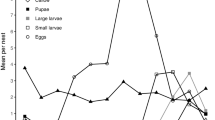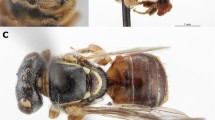Abstract
The large carpenter bees nest in reeds, stems and wood. Many other Hymenoptera, including many wasps and some bees, have strong associations between the physical elements of their nests and behavior. Nests of the North American carpenter bee, Xylocopa virginica, were collected in southern Ontario. Nest architecture elements were examined with respect to their impact on life-history elements. In particular, it was determined that the brood cells are provisioned sequentially both within and among branches. There was also no detectable pattern of sex allocation in broods. Nests with branched architecture contained more foundresses, but these foundresses did not appear to contribute in the construction of larger nests. These findings are discussed with respect to other bees, and to the social structure of Xylocopa virginica.



Similar content being viewed by others
References
Bosch J, Vicens N (2006) Relationship between body size, provisioning rate, longevity and reproductive success in females of the solitary bee Osmia cornuta. Behav Ecol Sociobiol 60:26–33
Daly HV (1966) Biological studies on Ceratina dallatorreana, an alien bee in California which reproduces by parthenogenesis (Hymenoptera: Apoidea). Ann Entomol Soc Am 59:1138–1154
Daly HV, Michener CD, Moure JS, Sakagami SF (1987) The relictual bee genus Manuelia and its relation to other Xylocopinae (Hymenoptera: Apoidea). Pan Pac Entomol 63:102–124
Dhaliwal HS, Kapil RP (1968) Defence of nest by the female of Xylocopa fenestrata Fab. (Xylocopinae, Hymenoptera). Insect Soc 15:419–422
Gerling D, Hermann HR (1976) Biology and mating behavior of Xylocopa virginica L. (Hymenoptera, Anthrophoridae). Behav Ecol Sociobiol 3:99–111
Gerling D, Velthuis HHW, Hefetz A (1989) Bionomics of the large carpenter bees of the genus Xylocopa. Annu Rev Entomol 34:163–190
Hansell MH (1993) The ecological impact of animal nests and burrows. Funct Ecol 7:5–12
Hurd PD (1978) An annotated catalogue of the carpenter bees (Genus Xylocopa Latreille) of the Western hemisphere (Hymenoptera: Anthophoridae). Smithsonian Institute, Washington
Iwata K (1964) Egg giantism in subsocial Hymenoptera, with ethological discussion on tropical bamboo carpenter bees. Nat Life Southeast Asia 3:339–435
Jeanne RL (1975) The adaptiveness of social wasp nest architecture. Q Rev Biol 50:267–287
Karsai I, Wenzel J (1998) Productivity, individual-level and colony-level flexibility, and organization of work as consequences of colony size. Proc Natl Acad Sci USA 95:8665–8669
Maeta Y, Miyanaga R, Sugiura N, Lu SS (1996) Additional notes on the nesting habits of the Taiwanese bamboo carpenter bee, Xylocopa (Biluna) tranquebarorum tranquebarorum (Hymenoptera, Anthophoridae). Jpn J Entomol 64:669–680
Michener CD (1969) Comparative social behavior of bees. Annu Rev Entomol 14:299–342
Michener CD (1974) The social behavior of the bees, a comparative study. Harvard University Press, Cambridge
Michener CD (1985) From solitary to eusocial - need there be a series of intervening species. Fortschr Der Zool 31:293–305
Michener CD (1990) Caste in Xylocopine bees. In: Engels W (ed) Social Insects: An evolutionary approach to castes and reproduction. Springer Verlag, Berlin New York, pp 120–144
Michener CD, Kerfoot WB (1967) Nests and social behavior of three species of Pseudaugochloropsis. J Kansas Entomol Soc 40:214–232
Minckley RL (1998) A cladistic analysis and classification of the subgenera of the large carpenter bees, tribe Xylocopini (Hymenoptera: Apidae). Scientifc Papers, Natural History Museum, The University of Kansas 9:1-47
Packer L (1988) The effect of Bombylius pulchellus (Diptera; Bombyliidae) and other mortality factors upon the biology of Halictus ligatus (Hymenoptera; Halictidae) in southern Ontario. Can J Zool 66:611–616
Packer L (1991) The evolution of social behavior and nest architecture in sweat bees of the subgenus Evylaeus (Hymenoptera: Halictidae): A phylogenetic approach. Behav Ecol Sociobiol 29:153–160
Packer L, Sampson B, Lockerbie C, Jessome V (1989) Nest architecture and brood mortality in four species of sweat bee (Hymenoptera: Halictidae) from Cape Breton Island. Can J Zool 67:2864–2870
Prager SM (2008) Behaviour and life history of a large carpenter Bee (Xylocopa virginica) in the northern extent of its range (PhD). Brock University, St. Catharines, p 241
Rau P (1933) The jungle bees and wasps of Barro Colorodo Island (with notes on other insects). Kirkwood, St Louis
Sakagami SF, Maeta Y (1977) Some presumably presocial habits of Japanese Ceratina bees, with notes on various social types in hymenoptera. Insect Soc 24:319–344
Skaife SH (1952) The yellow-banded carpenter bee Mesotrichia caffra (Linn.) and its symbiotic mite, Dinogamassus braunsi. J Entomol Soc SA 15:61–76
Stark RE (1992a) Cooperative nesting in the multivoltine large carpenter bee Xylocopa sulcatipes Maa (Apoidea: Anthophoridae): Do helpers gain or lose to solitary females? Ethology 91:301–310
Stark RE (1992b) Sex ratio maternal investment in the multivoltine large carpenter bee Xylocopa sulcatipes (Apoidea: Anthophoridae). Ecological Entomology 17:160-166.
Steen Z (2000) Social behavior in endemic Australian carpenter bees (PhD). Flinders University of South Australia, Adelaide, p 205
Steen Z, Schwarz MP (2000) Nesting and life cycle of the Australian green carpenter bees Xylocopa (Lestis) aeratus Smith and Xylocopa (Lestis) bombylans (Fabricius) (Hymenoptera: Apidae: Xylocopinae). Aust J Entomol 39:291–300
Stokes M, Davis CS, Koch GG (2000) Categorical data analysis using the SAS system, 2nd edition. SAS Press
Thoenes SC, Buchmann SL (1994) Fan palm as an urban nesting substrate for Xylocopa californica arizonensis Cresson (Hymenoptera: Anthophoridae). Pan Pac Entomol 70:330–332
Velthuis HHW, Wolf Y, Gerling D (1984) Provisioning and preparation of the brood cell in two carpenter bees, Xylocopa sulcatipes Maa and Xylocopa pubescens Spinola (Hymenoptera: Anthophoridae). Isr J Entomol 18:39–51
Vicidomini S (1996) Biology of Xylocopa violacea (Hymenoptera): In-nest ethology. Ital J Zool 63:237–242
Watmough RH (1983) Mortality, sex ratio and fecundity in natural populations of large carpenter bees (Xylocopa spp.). J Anim Ecol 52:111–125
Acknowledgements
We thank the St. Catharines Parks Department for aid in collecting nests at Burgoyne Woods. This project benefited from discussions with J. Richardson and comments from three anonymous reviewers. SMP was funded by a National Science Engineering Research Council discovery grant to M.H. Richards and by funding from the Brock University Faculty of Mathematics and Science.
Author information
Authors and Affiliations
Corresponding author
Rights and permissions
About this article
Cite this article
Prager, S.M., Hunter, F.F. Relationships between Nest Architecture and Behavior in Xylocopa virginica (Hymenoptera: Apidae). J Insect Behav 24, 293–306 (2011). https://doi.org/10.1007/s10905-011-9256-x
Revised:
Accepted:
Published:
Issue Date:
DOI: https://doi.org/10.1007/s10905-011-9256-x




